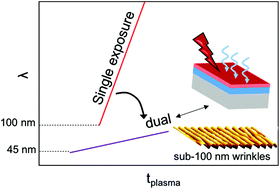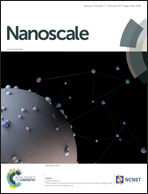Abstract
We demonstrate nanoscale wrinkling on polydimethylsiloxane (PDMS) at sub-100 nm length scales via a (double) frontal surface oxidation coupled with a mechanical compression. The kinetics of the glassy skin propagation is resolved by neutron and X-ray reflectivity, and atomic force microscopy, combined with mechanical wrinkling experiments to evaluate the resulting pattern formation. In conventional PDMS surface oxidation, the smallest wrinkling patterns attainable have an intrinsic lower wavelength limit due to the coupling of skin formation and front propagation at fixed strain εprestrain, whose maximum is, in turn, set by material failure. However, combining two different oxidative processes, ultra-violet ozonolysis followed by air plasma exposure, we break this limit by fabricating trilayer laminates with excellent interfacial properties and a sequence of moduli and layer thicknesses able to trivially reduce the surface topography to sub-100 nm dimensions. This method provides a powerful, yet simple, non-lithographic approach to extend surface patterning from visible to the deep UV range.



 Please wait while we load your content...
Please wait while we load your content...